Hmongtown Marketplace
Hmongtown Marketplace is an indoor market focused on Hmong-American products and culture in the Frogtown neighborhood of Saint Paul, Minnesota. Hmongtown is noted for its cuisine and produce, with major local paper the Star Tribune calling the food court "one of the state's top culinary gems."[5] It is variously referred to as the Hmong Farmers Market or Hmong Flea Market, or simply "Hmongtown" to emphasize its role as a cultural hub like a Chinatown, not just a retail location.[3][6]
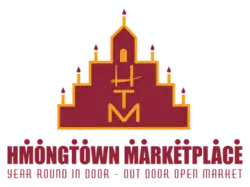 | |
| Location | Saint Paul, Minnesota, United States |
|---|---|
| Coordinates | 44°57′41″N 93°06′34″W |
| Address | 217 Como Ave, St Paul, MN 55103 |
| Opening date | 2004[1] |
| Owner | |
| No. of stores and services | 200–300[3][1] |
| Total retail floor area | 6 acres[4] |
| No. of floors | 1 |
| Website | https://hmongtownmarketplace.com/ |
More than 200 vendors sell traditional food, clothing, and home goods especially from Hmong and Hmong-American culture, including from Cambodia, Vietnam, Laos and Thailand.[7] An indoor produce market designed to simulate open-air markets in Chiang Mai, Thailand, and Vientiane, Laos sells culturally specific fruits, vegetables, nuts, and other edible plants.[8] Hot and ready made food vendors throughout the market and in the food court sell a variety of dishes such as roast meats, boba tea, papaya salad, and bánh mì.[1] Home goods include green market, electronics, religious supplies, and garden tools.[9][5]
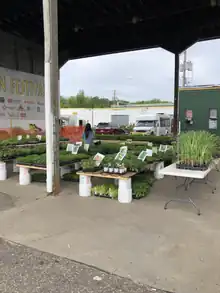
In the summer the market nearly doubles in size with an outdoor market in the surrounding paved lot that brings the number of vendors up to 300 or more.[3] The outdoor market is sometimes referred to as the Hmongtown Farmers Market and sells produce as well as meat, clothing and textiles, herbal medicine, live potted plants, and home products.[10]
The large size and foot traffic thave led to the nickname "Hmong Mall of America". 600 people work inside, as many as 20,000 customers have been noted during events, and there is capacity for more than 300 stalls.[4] The interior footpath complexity due to the many stalls has been described as "labyrinthine" and "byzantine."[11][10]
Culture
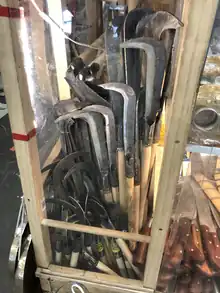
Hmong are the largest Asian diaspora in Minnesota, and Minnesota has the second largest Hmong population in the United States.[12] Hmongtown is a staple of local Hmong life and creates a sense of community and belonging.[1] Less then four miles away is a similar Hmong-American marketplace called Hmong Village.[13][14]

Vendors at Hmongtown sell traditional Hmong textile art such as kawm (woven baskets) and forms of Paj Ntaub (flower cloth) such as batik dyed cloth (Paj Ntaub nraj ciab/cab[15]) and story cloth, which depicts scenes from Hmong life and history.[16]
While the focus is Hmong culture, the marketplace contains shops and stalls with proprietors and products from any of the cultures that can be found in the surrounding neighborhood Frogtown, which is the most racially diverse neighborhood in Minnesota. Nepali and Mexican vendors have been noted.[17] Owner Toua Xiong aims for the market to be welcoming to those new to Hmong culture.[7]
Cuisine
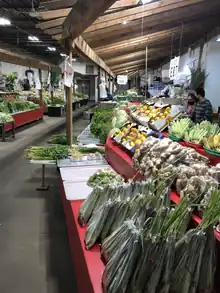
Hmongtown is noted for its prepared food and quality produce, with the Star Tribune calling it "one of the state's top culinary gems"[5] and Saveur enthusing it's a "destination" for cooks.[13] Minnesota-native food critic Andrew Zimmern says it's "the country’s best little-known ethnic market."[18] Minnesota Monthly included Hmongtown in their "'culinary canon' of essential local eats"[19] list the "Foodie 40", saying Hmongtown is "one of the great, affordable flavor adventures in the Twin Cities" and calling it "ground zero" for good chicken wings.[20][21] The average price of a meal is less than $15 and restaurants are open all day for breakfast, lunch, and dinner.[22]
Individual restaurant stalls and a food court serve traditional Hmong and Southeast Asian meals, snacks, and street food.[23] Because Hmong is a diaspora, Hmong cuisine is a fusion, so dishes at Hmongtown come from Tailand, Laos, Cambodia, Vietnam, and even China, Japan, South Korea, and Mexico. Difficult to find outside of Minnesota, Hmong-style barbecue is prominent, including traditionally prepared and cold Hmong sausage (nyhuv ntxwm hmoob), which is a pork sausage flavored with Thai chili and lemongrass, and sai krok, a traditional fermented pork sausage.[13][24][25][26] Dishes popular among Hmong such as pho, khaub poob (curry noodles), larb (minced meat salad), nab vam (tapioca dessert), purple rice,[27] boba tea, mangonada,[28] and papaya salad are widely available from multiple restaurants.[29]
Notable vendors and dishes include:
- 5-Star Deli: fried chicken wings with egg roll stuffing (kooj tis qaib nitim[30]); chicken meatball skewer; nab vam (colorful jelly and fruit dessert)[31][5][13][20]
- Golden Cuisine: whole roast chicken larb[20]
- Her Kitchen: beef pho[5]
- Hmong Express Cuisine: papaya salad[18]
- Hmobb Kitchen: mok pa (banana leaf steamed catfish)[5]
- Hmoob Cafe: shellacked beef ribs; mustard greens with pork; mok pa; papaya salad[20]
- Kad's Deli: jian dui (filled Chinese donut)[5]
- Mr. Papaya: crispy pork belly, spiced green mango[31][5]
- Mai's Kitchen: sai krok (fermented pork sausage)[25]
- Sida Kitchen: foot-long Thai or Lao style Hmong sausage[5]
- Twin Tropic Cafe: chocolate and blackberry smooth bubble teas; meatball soup[20]
- Xieng Khoung Kitchen: spring rolls[5]
Hmongtown is recommended for its cuisine in many travel guides such as Lonely Planet and Condé Nast Traveler.[32][33]
An outdoor market that sells much of the same merchandise as the indoor market operates from May to October. It has an emphasis on fresh produce and starter plants for gardening vegetables.[34][35]
Produce commonly available at Hmongtown has Southeast Asian origins and is difficult to find in mainstream groceries. A large portion of the produce is locally grown by Hmong farmers.[10][26]
- rambutan[36][13]
- Hmong yellow and red cucumbers[13]
- bitter melon[13][27]
- purple lemongrass[13][27][10]
- sugar cane[13]
- Thai chili[13]
- pea eggplant[13][27]
- dried imported bamboo[13][10]
- winter melon[13]
- radish greens[13]
- bok choy[13]
- Chinese broccoli[27]
- Thai basil[10]
- longan[10][26]
- lychee[10]
- pomelo[37]
- mangosteen[37]
- persimmon[26]
Events
In June 2016 Hmongtown held the first Hmongtown Festival, a two-day music and cultural festival focusing on Hmong history and culture.[7] The owner Toua Xiong who learned to sing and play guitar in a refugee camp played at the first festival.[3]
Hmongtown held vaccine clinics during the beginning of the COVID-19 pandemic.[38]
Traditional medicine
Hmongtown vendors sell traditional Hmong and Southeast Asian medicine such as herbs and imported over the counter drugs.[13]
In June 2013, Ramsey county deputy sheriff, Saint Paul Police, and federal agents executed a raid on Hmongtown and confiscated hundreds of pounds of illegal medication, including penicillin, opiates, and mislabeled over the counter medication. Vendors were subjected to full body searches. Cultural differences and language barriers were blamed, although Ramsey County Sheriff's office spokesperson Randy Gustafson said that vendors had been previously warned against selling the products confiscated. 14 vendors were ultimately charged with "selling misbranded drugs, possessing and selling drugs that require a license, selling syringes, and unlawfully possessing poison."[39]
The Minnesota Department of Health started an educational series with Hmongtown vendors to explain drug safety and American regulations in response.[40][39] A similar incident occurred at the nearby Hmong Village shopping center in 2018.[41]
Expansion
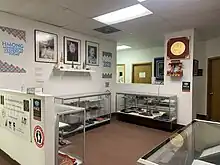
Hmongtown plans to someday expand to Hmong senior daycare and senior housing, and include more Hmong cultural activities such as an art gallery, music performance, and permanent history exhibits.[3] Underground parking and an office building are also planned.[4]
Off-site expansion includes nonprofits and museums. Through Hi Hi LLC, Toua Xiong and his wife Nou Xiong founded a Hmong and Karen cultural center and museum a few blocks from Hmongtown. Xiong envisions someday publishing Hmong recipes to preserve their cuisine. He also runs Hmong Connections, a cultural exchange program.[37][42]
History
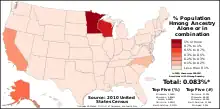
Hmongtown was the first Hmong-owned and operated market in the United States.[37][43] The market was founded as International Marketplace[37] in 2004 by Saint Paul, Minnesota entrepreneur Toua Xiong.[1] Hmong people were persecuted in their homelands following the Laotian Civil War known as the Secret War and Xiong wanted a place for first generation immigrants such as himself to gather as though they were at home. The marketplace originally had many video stores that sold footage of and movies set in Laos and Thailand as part of that nostalgia.[43]
Xiong remembers his childhood in Laos before his family escaped to a refugee camp: “The sadness is always burning in me. We don’t have a country. We were chased, and chased. I had no reason to be chased into the jungle at 7. I made no mistake. The [refugee] camps were a prison. I am as capable as any person, but I never had a chance.” Xiong, a younger brother, and his parents joined his teenage brothers in an American-run refugee camp when he was 12. At 17 years old he and his wife immigrated to St. Paul, Minnesota and settled in Frogtown.[3] In three years he gained college degrees in business and accounting.[7][37]
The 6-acre[4] site was previously Shaw Stewart Lumber Co. on Como Avenue, north of the St. Paul Capitol building. Most of the original buildings remain, with the largest warehouse functioning as the main market building. Xiong didn't realize the obstacles to redeveloping the property for grocery and retail when he rented it from the lumber company, having only recently become a business owner and an English speaker. Renovations to meet regulations included a sprinkler system, more toilets, exhaust fans in restaurant spaces, and an upgraded larger sewer pipe to connect to the municipal system. Despite setbacks, he opened Hmongtown in 2004.[3][13]
In 2009 he bought the property from the lumber company and renamed it Hmongtown Marketplace.[4][37]
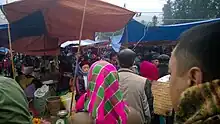
When Hmong began immigrating to Minnesota in the 1980s, there was no cultural hub such as Hmongtown, which made it difficult for refugees to find the supplies and foods they preferred. The market was an ambitious effort to change that.[7] Hmongtown has been credited with creating hundreds of jobs and other entrepreneurial opportunities for much of the Minnesota Hmong diaspora.[44] Most of the vendors speak only a Hmong dialect and not English, which Xiong notes allows them to maintain employment and start a business while still acclimating to America.[3][7][37]
In 2010 Xiong was awarded the Immigrant of Distinction award for his work at Hmongtown from the Minnesota-Dakotas chapter of the American Immigration Lawyers Association.[37]
See also
References
- "What's at Hmongtown Marketplace?". Meet Minneapolis. Explore Minnesota. Archived from the original on 8 June 2023. Retrieved 18 October 2023.
- "Starter Plants at HmongTown Marketplace". YouTube. HmongTown Marketplace. 9 June 2023. Retrieved 21 October 2023.
- Moskowitz Grundahl, Dara (30 November 2018). "Meet the King of St. Paul's HmongTown". Mpls.St.Paul Magazine. Key Enterprises LLC. Archived from the original on 25 November 2022. Retrieved 18 October 2023.
- Burger, Kevyn. 2017. “Immigrant: Success Stories: Tales of Four Minnesota Entrepreneurs Form India, Nicaragua, Laos and Nigeria – and a Visit with the Head of Global Minnesota.” MinnesotaBusiness 27 (9): 18–24. Archived 2023-10-20 at the Wayback Machine.
- Rayno, Amelia (2 May 2018). "10 must-eat foods at St. Paul's two massive Hmong markets". Star Tribune. Archived from the original on 9 June 2023. Retrieved 18 October 2023.
- "LTHForum.com - Hmong Food and Culture in Saint Paul MN". www.lthforum.com. Retrieved 2023-10-22.
- "Finding Minnesota: Hmongtown Marketplace". CBS News Minnesota. WCCO News. 5 June 2016. Retrieved 20 October 2023.
- Lee, Mai Na M. (7 December 2021). "Hmong and Hmong Americans in Minnesota". MNopedia. Minnesota Historical Society. Retrieved 20 October 2023.
- Johnson, Cecilia (8 November 2022). "These 16 Twin Cities Grocery Stores Have Really Great Cafes Inside Them". Eater. Archived from the original on 20 October 2023. Retrieved 18 October 2023.
- Ross, Jason (11 June 2012). "A Chef's Guide to Shopping the Hmongtown Marketplace". Minnesota Monthly. Greenspring Media, LLC. Archived from the original on 30 March 2023. Retrieved 18 October 2023.
- Halpern, Ashlea. 2019. “The Twin Cities...Where You Can Take a World Food Tour without Leaving Minnesota.” Bon Appetit 64 (5): 43–46. Archived 2023-10-20 at the Wayback Machine.
- Yang, Nancy (1 March 2015). "10 things about Hmong culture, food and language you probably didn't know". MPR.org. Archived from the original on 4 June 2023. Retrieved 18 October 2023.
- Raposo, Jacqueline (11 December 2015). "Taste Stuffed Chicken Wings and Magical Herbs at St. Paul's Hmongtown Marketplace". Saveur. Another Little Whisk LLC. Archived from the original on 4 February 2023. Retrieved 18 October 2023.
- Frank Jossi. 2023. “Building Blocks: Hmong Village Shopping Center.” Finance & Commerce (Minneapolis, MN). Accessed October 19. Archived 2023-10-20 at the Wayback Machine.
- Peterson, Sally N. (1990). From the Heart and the Mind: Creating Paj Ntaub in the Context of Community (Publication No. 9026627) [Doctoral dissertation, University of Pennsylvania]. ProQuest Dissertation Publishing.
- Craig, Geraldine, "Neeg Tawg Rog (War-torn People): Linguistic Consciousness in the Hmong diaspora" (2012). Textile Society of America Symposium Proceedings. 671. Archived 2023-08-06 at the Wayback Machine
- "Lekali Pasal: A Nepali Store in the Hmongtown Marketplace (St. Paul. MN)". My Annoying Opinions. 11 September 2018. Retrieved 21 October 2023.
- Zimmern, Andrew. "Only in Minnesota #OnlyinMN". Andrew Zimmern. Retrieved 21 October 2023.
- "Appetites: A foodie's 40 best local eats". MPR News. Minnesota Public Radio. 25 February 2015. Retrieved 21 October 2023.
- Derusha, Jason, and Joy Summers. 2018. "Hmongtown Marketplace: Sample Authentic Asian Flavors in St. Paul.” Minnesota Monthly 52 (4): 60. Archived 2023-10-20 at the Wayback Machine.
- Hutton, Rachel (23 April 2015). "Foodie 40: The Ultimate Checklist of Minnesota's Best Food". Minnesota Monthly. Greenspring Media, LLC. Retrieved 21 October 2023.
- "Hmongtown Marketplace". Explore Minnesota. Retrieved 20 October 2023.
- Green, Loren. "International Flavors Spice Up the Twin Cities". Explore Minnesota. Retrieved 20 October 2023.
- Bos, Mecca (8 March 2018). "5 barbecue dishes you can (mostly) only get in Minnesota". Bring Me the News. The Arena Group. Retrieved 20 October 2023.
- Spratte Joyce, Katy (6 October 2021). "Required Eating: 10 Foods Not to Miss in Minnesota". Afar. Afar Media. Retrieved 20 October 2023.
- Dunbar, Elizabeth (14 April 2010). "Celebrating spring with a trip to the Hmong market". MPR News. Minnesota Public Radio. Retrieved 21 October 2023.
- Summers, Joy. "The First Five Dishes to Try Inside Saint Paul's Hmong Food Halls". Visit Saint Paul. Retrieved 20 October 2023.
- "In Their Own Words: Oskar Ly's Favorite Restaurants". Visit Saint Paul. Visit Saint Paul Official Convention & Visitors Bureau. Retrieved 20 October 2023.
- "Hmong History and Saint Paul". Visit Saint Paul. Retrieved 20 October 2023.
- "Prix Fixe Hmong Dinner". Rose City Book Pub. 2023-05-20. Retrieved 2023-10-24.
- "Five Tastes from Hmongtown in Saint Paul – Heavy Table". heavytable.com. Retrieved 2023-10-22.
- Walker, Benedict; Armstrong, Kate; Bain, Carolyn; Balfour, Amy C; Bartlett, Ray; Clark, Gregor; Grosberg, Michael; Karlin, Adam; Kluepfel, Brian (2018). Lonely Planet Eastern USA. Lonely Planet. ISBN 978-1787019584. Archived from the original on 2023-10-20. Retrieved 2023-10-20.
- Halpern, Ashlea (27 April 2021). "Where to Eat, Stay, and Play in Minneapolis". Condé Nast Traveler. Condé Nast. Retrieved 20 October 2023.
- "Your Guide to Farmers' Markets in Saint Paul". Visit St. Paul. Visit Saint Paul Official Convention & Visitors Bureau. Retrieved 20 October 2023.
- Crystal, Jen (24 July 2023). "10 Must-Visit Farmers Markets Across the Midwest". MidwestLiving. Dotdash Meredith. Retrieved 20 October 2023.
- "Eating at Hmongtown Marketplace, November 2022 (St. Paul, MN)". My Annoying Opinions. November 2022. Retrieved 20 October 2023.
- Treacy, Mary (4 July 2010). "Toua Xiong, Immigrant of the Year". Twin Cities Daily Planet. Twin Cities Enterprise. Retrieved 21 October 2023.
- Cox, Peter (3 May 2022). "Hmong health leaders stepped up as COVID ravaged community". MPR News. Minnesota Public Radio. Retrieved 21 October 2023.
- Yang, Mai Tong (14 August 2014). "Hmong vendors learn the law on legal drug sales". MPR News. Minnesota Public Radio. Retrieved 21 October 2023.
- Shenoy, Rupa (5 July 2013). "Hmongtown Marketplace raid leaves businesses, patrons off balance". MPR News. Minnesota Public Radio. Retrieved 21 October 2023.
- Yuen, Laura (10 October 2018). "Authorities investigate medications sold at St. Paul's Hmong Villiage". MPR News. Minnesota Public Radio. Retrieved 21 October 2023.
- Melo, Frederick (14 October 2020). "Hmongtown Marketplace founder plans cultural center at Klub Haus on Rice Street". Twin Cities.com/Pioneer Press. Media News Group. Retrieved 21 October 2023.
- "Hmongtown Marketplace". Religions in Minnesota. Carleton University. Archived from the original on 23 May 2022. Retrieved 18 October 2023.
- Yang, Kou (2017). The Making of Hmong America: Forty Years after the Secret War. Lexington Books. p. 88. ISBN 978-1498546461. Archived from the original on 2023-10-20. Retrieved 2023-10-20.